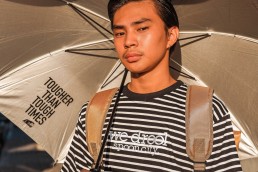
The worlds of clothing and style are diverse, and sometimes intimidating upon first approach. I myself got into clothes a little over a decade ago, and one style of clothing I’d frequently encountered during my meandering initial steps was the “Ivy League” or “Preppy” style. I’d never focused on it too much, as some of my research led me to believe it was a rather rule-laden way to look at one’s wardrobe. The more I learned, however, the more I realized some people’s takes on the matter weren’t representative of everyone with an appreciation for it.
Regardless of my initial impressions, I was always aware that advocates and enthusiasts of this style care very deeply about its history and the quality of their garments. One place in Manila that really focuses on classic menswear (and thus Ivy League by extension) is Signet, a retailer that focuses on exceptionally-crafted garments, steeped in history and/or narrative.
Thanks to the kind people at Signet, I (alongside their team member Don Ching) recently had the chance to sit down with Rowing Blazers founder Jack Carlson and hear about how Rowing Blazers came to be, as well as get his perspectives on Ivy League styling, the way people dress today, and some things in the pipeline for the brand.

Jack Carlson of Rowing Blazers. Image — Yumi Matsuo
One of the first things to note is that Ivy League style is something of a continuum: it’s always moved through the ages, but kept a few things close to heart as it grew. Jack is very aware of the history of the blazer as an object: it really began as a sort of warm up jacket in the context of rowing. It might be difficult to imagine the blazer as an early form of sportswear, but it could be said that that’s what it was back then. Rowing Blazers as a brand started with Jack’s exposure to all the different blazers from rowing clubs all over the world: the genesis would probably be when he wrote a book on these blazers and their stories and traditions. The Ivy League style has its roots in when blazers and their ilk began to be worn outside of their initial contexts. It was refreshing to consider that this style began as youths wanting to distinguish themselves from how their fathers dressed, and so began a lot of the classic menswear tropes:

“I think that whatever you wanna call it, say, a “classic American collegiate style”, some term like that, it’s very timeless and it can be very fun. It’s very colorful, and there’s some really good stuff that came out of that world that really resonates with me. We’re talking about bright colors in clothing, fabrics like corduroy, madras, tweed, seersucker, all the great kinds of traditional fabrics. Polo shirts, rugby shirts, button down oxford shirts. […] That’s the world that I think of, and I think that if it’s possible to take the good stuff and leave out the stuffiness and negative baggage that comes with it; interject the sense of fun, rebelliousness, humor and almost kind of irony with which these things were originally worn […]”
Nowadays, menswear (but really just how people dress, in general) has been changed so much by the internet and our phones. It may seem like an obvious enough observation, but what that leads to is a series of new approaches, even outside of the context of getting dressed. Highly informed is the new normal:
“The way thoughtful people are dressing is really cool and interesting, because it’s a lot more informed and eclectic than ever. Thanks to phones and the Internet, people are now able to do a lot more of their own research and homework about clothing, what they’re wearing, and why certain things were historically or originally done a certain way. They’re able to educate and acquaint themselves with many different worlds when it comes to style and clothing. I think people are a lot less easily categorized or pigeonholed now […]”
Rowing Blazers pieces worn by Signet Team Miggy Acosta and Brian Ver, and writer Julio Del Prado. Images — Marvin Conanan
I think it’s these perspectives that’s helped Rowing Blazers appeal to so many different kinds of people: the knowledge behind product history and reasoning is present and wonderfully executed, but so is that easy going spirit. “At the end of the day, they’re just clothes.”
True, but lovely clothes nonetheless.

The full, in-depth interview with Jack Carlson is available via the PURVEYR Newsletter. If you haven’t subscribed yet, please visit this page to receive the full interview this Wednesday, April 21, 2021, and other exclusive content and offers from our team.
Rowing Blazers is available at Signet. You can also keep up with Jack on his personal Instagram, and check out more from Rowing Blazers on their Instagram and official website.










